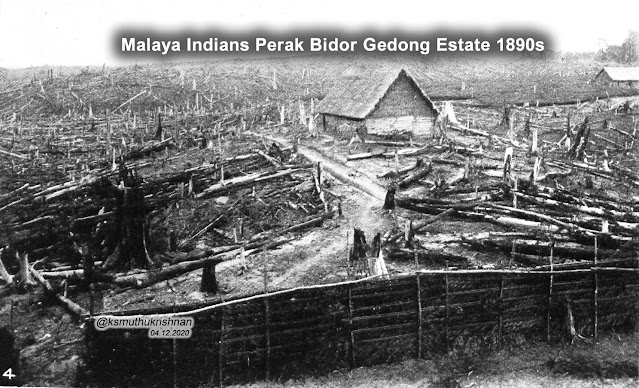மலேசியாவில் மிகப் பழைமையான தோட்டங்களில் ஒன்றாகும். 1860 அல்லது 1870-ஆம் ஆண்டுகளில் தோற்றுவிக்கப்பட்டு இருக்கலாம். அந்தக் காலக் கட்டத்தில் புகைப்பட சாதனங்களின் பயன்பாடுகள் குறைவு. அதனால் மலாக்கோப் தோட்டத் தொழிலாளர்களின் படிமங்கள் உள்ளூர் தரவுகளில் இல்லாமல் போய் விட்டன.
Malakoff Estate in Province Wellesley is one of the oldest rubber estates in Malaysia. It may have originated in the 1860s or 1870s. The use of photographic equipments were rare during those days. As that images of Malakoff Estate workers are also not available from the local archives and as well as from external foreign archives.

இருப்பினும் ஜி. ஆர். லம்பேர்ட் & கம்பெனி (G. R. Lambert & Co) புகைப்பட நிறுவனம் 1875 அல்லது 1876-ஆம் ஆண்டில் எடுத்த புகைப்படங்கள் கிடைத்து உள்ளன. 1872-ஆம் ஆண்டு படம் என்று பதிவு செய்து உள்ளேன்.
However photographs taken by Lambert & Company (G. R. Lambert & Co) sometimes in 1875 or 1876 are available. The year recorded here as 1872.
பினாங்கு செபாராங் பிறை மலாக்கோப் தோட்டத்தில் (Malakoff Estate Province Wellesley), முதன்முதலில் மரவள்ளிக் கிழங்கு பயிர் செய்யப்பட்டது. நல்ல தரமான மரவள்ளிக் கிழங்குகளை உற்பத்தி செய்து இருக்கிறார்கள். உலகத் தரம் வாய்ந்த மரவள்ளிக் கிழங்கு மாவை மலாயாவில் இருந்து ஐரோப்பிய நாடுகளுக்கு ஏற்றுமதி செய்து இருக்கிறார்கள்.
Cassava was first cultivated in Malakoff Estate. They produce good quality cassava tubers. World class cassava dough is exported from Malaya to European countries.

1878-ஆம் ஆண்டு பிரான்ஸ் நாட்டின் பாரிஸ் நகரில் ஒரு வேளாண்மைக் கண்காட்சி நடைபெற்றது. அதில் மலாக்கோப் தோட்ட மரவள்ளிக் கிழங்கு மாவு காட்சிக்கு வைக்கப்பட்டது. அந்தக் கண்காட்சியில் உற்பத்தி தகுதிக்கான சிறப்பு பரிசுகளும் விருதுகளும் கிடைத்து உள்ளன.
In 1878 an agricultural exhibition was held in Paris, France. Malakoff Estate's cassava flour was on display. It won special prizes and awards for productivity at the exhibition.
வருடத்தைக் கவனியுங்கள். 1878. ஆக இந்த ஒரு சான்றுப் படிமமே போதும். மலாக்கோப் தோட்டத்தின் வரலாறு பழைமையானது என்பதை அந்தச் சான்று மெய்ப்பிக்கின்றது.
Note the year. 1878. This one proof is just enough. This evidence confirms that the history of the Malakoff Estate dates back to a much longer period.

1907-ஆம் ஆண்டு மலாயா வேளாண்மை பற்றி Twentieth century impressions of British Malaya: its history, people, commerce, industries, and resources எனும் நூல் எழுதப்பட்டது. அந்த நூலின் 377-ஆம் பக்கத்தில் மலாக்கோப் தோட்டத்தின் அமைப்பைப் பற்றி விளக்கமாக எழுதி இருக்கிறார்கள்.
'Twentieth Century Impressions of British Malaya: its history, people, commerce, industries, and resources' was written in 1907. It is about Malayan agriculture. On page 377 of the book, there are some vital facts about the structure of Malakoff Estate.
மலாக்கோப் தோட்டத்தின் பரப்பளவு 5,380 ஏக்கர். சாகுபடி செய்யப்பட்ட நிலத்தின் மொத்தப் பரப்பளவு 2,211 ஏக்கர். அவற்றில்;
The area of Malakoff Estate was 5,380 acres. The total area of cultivated land was 2,211 acres. Among them;
969 ஏக்கர் மரவள்ளிக் கிழங்குச் சாகுபடி.
969 acres of cassava cultivation.
318 ஏக்கர் தென்னைச் சாகுபடி.
318 acres of coconut cultivation.
658 ஏக்கர் கலப்புச் சாகுபடி. (மரவள்ளிக்கிழங்கு; தென்னை கலப்பு)
658 acres of mixed cultivation. (Cassava; Coconut inter-planted)
245 ஏக்கர் ரப்பர் சாகுபடி.
245 acres of rubber cultivation.
21 ஏக்கர் வெற்றிலைச் சாகுபடி.
21 acres of betel cultivation.
இதில் ஒரு பெரிய வியப்பு. வெற்றிலை பயிர் செய்து இருக்கிறார்கள். அந்தக் காலக் கட்டத்தில் பினாங்குத் தமிழர்களில் பெரும்பாலோர் வெற்றிலை பயன்படுத்தி உள்ளார்கள்.
A big surprise. They have cultivated betel. Most probably in those days most of Penang Tamils were affected to betel addiction.

மலாக்கோப் தோட்டத்தில் தமிழர்களின் எண்ணிக்கை ஆண்கள் 69. பெண்கள் 52. பிள்ளைகள் 45. ஒரு குறிப்பிட்ட அளவிற்கு ஜாவானியர்களும், சீனர்களும் வேலை செய்து உள்ளார்கள்.
The number of Tamils in Malakoff Estate was 69 males. Females 52. Children 45. To a certain extent Javanese and Chinese were employed.
தமிழர்கள் வாழ்ந்த வீடுகள் நன்கு பராமரிக்கப்பட்டு உள்ளன. அவர்களின் உடல்நலத்திற்கு முக்கியத்துவம் வழங்கப்பட்டு உள்ளது. தோட்டத்தில் ஒரு மருத்துவமனையும் பராமரிக்கப்பட்டு உள்ளது. நிர்வாகியாக திரு. ஜார்ஜ் ஸ்டோத்தார்ட். இவர் புரவின்ஸ் வெல்லஸ்லி; பேராக் மாநிலங்களில் வேளாண்மைத் துறையில் பல வருட அனுபவம் பெற்றவர்.
The houses where the Tamils lived were well maintained. Emphasis had been placed on their health. A hospital was also maintained in the estate. Mr. George Stotthard was the manager of the estate. He had many years of experience in the field of agriculture in the states of Perak and Province Wellesley.
மலாக்கோப் தோட்டத்திற்கு அருகாமையில் உள்ள தோட்டங்கள்: பெர்த்தாம் தோட்டம்; சின் டெல்க் தோட்டம்; புக்கிட் தோ ஆலங் தோட்டம்; என்ஜி சென் தோட்டம்; ஹைலேங் தோட்டம்; சூங் லை ஹாக் தோட்டம்; எங் சூன் தோட்டம்; ஹாக் எங் தோட்டம்.
Estates adjacent to Malakoff Estate: Bertam Estate, Sin Telk Estate, Bukit Toh Alang Estate, Ng Sen Estate, Haileng Estate, Choong Lye Hock Estate, Eng Soon Estate, Hock Eng Estate.
மலாயா தமிழர்களின் வரலாறு நீண்ட நெடிய வரலாறு. பினாங்கு மாநிலத்தைப் பொறுத்த வரையில் தமிழர்களின் வரலாறு 1786-ஆம் ஆண்டு பிரான்சிஸ் லைட் காலத்தில் இருந்து தொடங்குகிறது. 235 ஆண்டு கால வரலாற்றைக் கொண்ட ஓர் இனத்தை வந்தேறிகள் என்று சொல்கிறார்கள். சொல்வதில் நியாயம் இல்லை. உண்மை நிலைக்க வேண்டும். சத்தியம் வெற்றி பெற வேண்டும்.
The history of the Malayan Indians has a long story. As far as the state of Penang is concerned, the history of the Indians dates back to the Francis Light period of 1786. A race which has a recent history of 235 years, yet being refereed as pentang. A mockery in history
(மலாக்கா முத்துக்கிருஷ்ணன்)
02.12.2020
Sources and References
1. Allen's Indian mail and register of intelligence for British and foreign India, 1878,7/12. Published on Jan 1878. Pages 664.
2. Report of the Committee on Emigration from India to the Crown Colonies and Protectorates, Part–III 1909, (Papers laid before the Committee No. 1), p: 111.
3. N. Gangulee, Indians in the Empire Overseas: A Survey The New India Publishing House Ltd, London,1947, p 175 26Ibid., p 199
4. Tinker, Hugh. The New System of Slavery: The Export of Indian Labour Overseas (1830 – 1920) Oxford University Press, London 1974, p 208.
5. Marilyn Gracey Augustine, In Search of a better destiny – Emigration of Tamils to Malayan Peninsula (1786-1910), 2008.
6. http://seasiavisions.library.cornell.edu/catalog/seapage:233_383

















